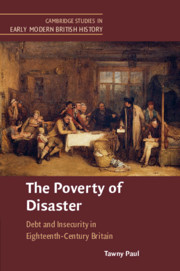Book contents
- The Poverty of Disaster
- Cambridge Studies in Early Modern British History
- The Poverty of Disaster
- Copyright page
- Dedication
- Contents
- Figures
- Tables
- Acknowledgements
- Introduction
- Part I Structures of Insecurity
- Part II The Insecure Self
- Chapter 4 Keeping in Credit
- Chapter 5 Occupational Identities and the Precariousness of Work
- Part III The Debtor’s Body
- Bibliography
- Index
Chapter 5 - Occupational Identities and the Precariousness of Work
from Part II - The Insecure Self
Published online by Cambridge University Press: 27 September 2019
- The Poverty of Disaster
- Cambridge Studies in Early Modern British History
- The Poverty of Disaster
- Copyright page
- Dedication
- Contents
- Figures
- Tables
- Acknowledgements
- Introduction
- Part I Structures of Insecurity
- Part II The Insecure Self
- Chapter 4 Keeping in Credit
- Chapter 5 Occupational Identities and the Precariousness of Work
- Part III The Debtor’s Body
- Bibliography
- Index
Summary
Chapter 5 focuses on constructions of occupational identity, which were central to notions of selfhood. Drawing on the diaries of three middle-rank tradespeople, and applying insights drawn from studies of female work to men’s productive activities, it considers the precariousness of work not only a function of maintenance, but as problem of identity. In an insecure economy, people took on multiple forms of employment in order to make ends meet. This complicated links between masculinity and work, because men were traditionally associated with a single occupation. The chapter investigates how men and their households established stable work identities. It considers the different forms that work took, and how words denoting labour such as ‘employment’ and ‘business’ were actually understood. Work was defined not only as monetised labour, but also as an activity that was productive or generated status and credit. Work’s value and contribution to identity and status changed over the course of the life cycle. It was carried out and understood in relation to others, especially men’s wives, rather than merely supporting notions of power and independence.
- Type
- Chapter
- Information
- The Poverty of DisasterDebt and Insecurity in Eighteenth-Century Britain, pp. 165 - 188Publisher: Cambridge University PressPrint publication year: 2019



